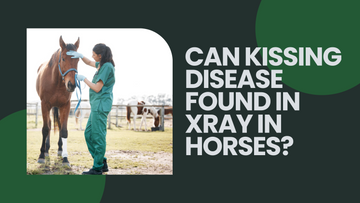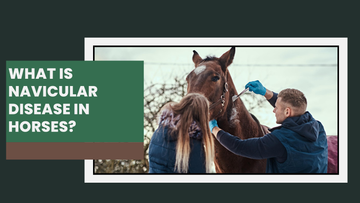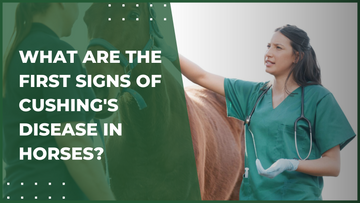Horses are known for their strength, but they also can’t escape the occasional back problem. Kissing spine disease might sound like a romantic twist, but it’s far from it. Instead of a loving embrace, it’s when the vertebrae in a horse’s back get too close, causing discomfort.
If your horse has been giving side-eye to the saddle, flinching when touched, or simply refusing to cooperate, then these could be symptoms of kissing spine in horses. Luckily, a kiss x-ray can reveal those unwelcome smooches between the vertebrae. But can a single X-ray really provide all the answers?
Don't worry! We'll help you understand how an X-ray can identify this issue, what other diagnostic options are available, and how to prevent it. The sooner it’s spotted, the faster your four-legged friend can feel their best!
What is Kissing Spine in a Horse?
Kissing spine disease in horses happens when the vertebrae in their back get too close, causing discomfort and pain. Instead of maintaining a healthy gap, the bony parts at the top of the vertebrae are called spinous processes or touch or overlap.
This condition, known as overriding or impinging dorsal spinous processes (ORDSP), generally occurs between the T13 to T18 vertebrae. That’s right under where the saddle and rider sit, making it even more uncomfortable for the horse.
While the vertebrae run from the first thoracic vertebra (T1) at the withers to the last lumbar vertebra (L6) near the hips, this mid-back section is the most commonly affected.
When a spine horse suffers from kissing spine disease, they may flinch when touched or show signs of irritability. Getting a clear image of this condition and being aware of the symptoms early can help your horse get the necessary care.
Kissing Spine Symptoms You Should Not Overlook
Horses may not speak our language, however they have their own ways of telling us when something doesn’t seem better. Regarding kissing spine disease in horses, their actions often speak louder than words. That is why early recognition of the kissing spine symptoms can make a big difference in your horse’s well-being.
Here are some necessary early signs of kissing spine in horses to watch out for:
-
Performance Issues: Stiff or tense back, making it hard for the horse to move smoothly. Trouble staying in a proper riding position and often holding its head high.
Difficulty switching between gaits or keeping a steady pace. Problems with cantering, like using the wrong lead, losing balance, or refusing to canter.
-
Physical Signs: Loss of muscle mass along the topline. Reluctance to lie down or roll due to discomfort. Visible flinching or twitching when pressure is applied to the back.
-
Behavioral Changes: Resistance or discomfort when grooming, especially over the back. Biting, pinning ears, or shifting weight when the saddle is placed. Refusal to stand still while mounting or reacting negatively to the rider’s weight.
-
Severe Reactions: Bucking, rearing, kicking out, or trying to bolt. Complicated aggressiveness or refusal to cooperate at the time of training.
Can Kissing Spine Be Detected on an X-ray?
Yes, X-rays are preferable for veterinarians when identifying kissing spine disease in horses. These reports or images give an overview of the vertebrae in a spine horse, which further helps vets to spot any signs of risk.
X-rays can reveal whether the bones are too close or overlapping by looking at the distance between the spinous processes. However, there are some struggles that we should not ignore while identifying this issue on X-rays.
-
Silent Signs: Approximately 39% of horses may show signs of kissing spine disease on X-rays without experiencing any pain.
-
Misleading Angles: It is also believed that the angle of the X-ray can affect how the vertebrae appear, sometimes leading to an overdiagnosis or underdiagnosis.
-
Need for a Complete Evaluation: X-rays alone aren't enough; vets rely on physical exams and the horse’s behavior to confirm kissing spine disease in horses.
As X-rays help diagnose kissing spine disease in horses, veterinarians rely on physical exams and ultrasounds for precise results. This guarantees the best treatment to help your horse feel their best.
Treatment Options for Kissing Spine Disease
When a spine horse is verified with kissing spine disease, the prime focus is to ease their pain and help them move comfortably. As there are plenty of treatment options available from gentle therapies to surgical procedures, depending on what your horse needs.

Non-Surgical Treatments
-
Pain Management and Muscle Relaxation: Vets often recommend anti-inflammatory medications and muscle relaxants to minimize discomfort.
-
Shockwave Therapy: This therapy uses sound waves to stimulate healing in the vertebrae and surrounding muscles. It’s a non-invasive option that can help reduce pain and promote faster recovery.
Physical Therapy and Rehabilitation:
-
Targeted Exercises: Physical therapy strengthens the back and abdominal muscles. Gentle stretching, groundwork exercises, and lunging can stabilize the horse’s posture, ease the strain, and restore flexibility.
-
Aqua Treadmill Training: Exercising on an aqua treadmill is a low-impact rehabilitation method that relieves joint pressure. The water provides resistance while supporting the horse’s body, making it an excellent choice for building strength.
-
Complementary Therapies: Alternative treatments like chiropractic adjustments, acupuncture, and therapeutic ultrasound are often used to reduce muscle tension and improve mobility. These therapies can be highly beneficial when used alongside other treatments.
Surgical Options:
-
Endoscopic Surgery: This minimally invasive technique involves removing selected vertebrae through small incisions. With a shorter recovery time than traditional surgery, it’s often preferred for moderate cases.
-
Interspinous Ligament Desmotomy (ISLD): The ligament between the vertebrae is cut to relieve tension in this procedure. It’s typically done with the horse standing under sedation, making it a less invasive and more accessible option.

Prognosis of Kissing Spine Diseases: What to Expect?
Being diagnosed with kissing spine disease in horses doesn’t mean the end of the road for your beloved spine horse. The prognosis largely depends on factors like the severity of the condition, how many vertebrae are affected, and the horse’s overall health.
Horses with mild to moderate kissing spine disease often respond well to non-surgical treatments, including pain management, physical therapy, and exercise programs to strengthen their back muscles.
In these cases, most horses can return to regular activities, including riding and competing. It’s worth noting that younger horses, typically under five years old, may have a slightly poorer prognosis, as their bones are still developing, making recovery more challenging.
How To Prevent Kissing Spine in Horses?
Preventing kissing spine disease in horses is all about keeping their backs strong, flexible, and free from unnecessary strain.

1. Ensure Proper Saddle Fit:
An ill-fitting saddle creates uneven pressure on the spine. Regular checks by a professional saddle fitter can prevent back strain.
2. Schedule Routine Vet Check-ups:
Regular vet visits can detect early signs of kissing spine disease in horses. X-rays and physical exams are essential for monitoring back health.
3. Watch for Behavioral Changes:
If your horse resists riding or shows discomfort, it may be an early sign of back pain. Early intervention can prevent worsening.
4. Maintain a Healthy Weight:
Excess weight increases spinal stress. A balanced diet and regular exercise keep your horse fit and reduce the risk of kissing spine disease.
Final Thoughts
Understanding kissing spine disease in horses helps to keep your equine friend comfortable and active. By remaining attentive to your horse's behavior and working closely with your veterinarian, you can assure they get the support they need.
For all your horse care needs, from durable spine horse essentials to grooming tools and tack, trust The Epic Animal. As one of the fastest-growing wholesalers in the equine industry, we offer a carefully curated selection of high-quality products to keep your horse happy and healthy.
For more insightful information and to explore our products, visit us now.

FAQs:
-
Can a horse recover from kissing spine?
Yes, with appropriate treatment, a horse can recover from kissing spine disease in horses Rehabilitation, exercise therapy, and occasionally surgery can aid in restoring mobility and comfort.
-
Is it okay to breed a horse with kissing spine?
Breeding a horse that has kissing spine disease could transmit genetic traits that result in structural problems. It's essential to consult a veterinarian to examine the risks and make the right decision for the spine horse.
-
Should I buy a horse that has a kissing spine?
Acquiring a horse with kissing spine disease may come with challenges. However, if managed correctly and the horse is at ease, it could still be suitable for light riding or as a companion.
-
Can you ride a horse with kissing spines?
Riding a horse affected by kissing spine disease in horses depends on how severe the condition is. With treatment and proper care, some horses may be able to resume light riding.
Read More Blog:







